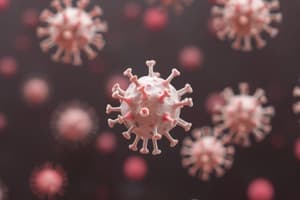Podcast
Questions and Answers
What three Greek words form the term 'microbiology'?
What three Greek words form the term 'microbiology'?
- Micro, bio, graph
- Mini, bio, logos
- Micro, bio, logos (correct)
- Macro, bio, logos
What size are microorganisms, in diameter, that they cannot be seen by the naked eye?
What size are microorganisms, in diameter, that they cannot be seen by the naked eye?
- More than 1 millimeter
- More than 1 centimeter
- Less than 10 centimeters
- Less than 1 millimeter (correct)
Which of the following is studied in bacteriology?
Which of the following is studied in bacteriology?
- Viruses
- Fungi
- Bacteria (correct)
- Protozoa
What is an organism that causes disease called?
What is an organism that causes disease called?
Which of the following describes a parasite?
Which of the following describes a parasite?
What is the term for microbes that live in or on another creature and benefit under normal conditions?
What is the term for microbes that live in or on another creature and benefit under normal conditions?
Which of the following describes a 'vector'?
Which of the following describes a 'vector'?
What is the term for the entry of microorganisms, especially pathogens, into the body?
What is the term for the entry of microorganisms, especially pathogens, into the body?
What is the period between the entry of microorganisms and the appearance of signs and symptoms called?
What is the period between the entry of microorganisms and the appearance of signs and symptoms called?
What term describes the prediction of the course of a disease?
What term describes the prediction of the course of a disease?
What is the study of the occurrence, distribution, and determinants of health and disease in a population called?
What is the study of the occurrence, distribution, and determinants of health and disease in a population called?
What is the term for an unusual, sudden outbreak of a disease in a specific region?
What is the term for an unusual, sudden outbreak of a disease in a specific region?
What is a disease that is usually found in a particular area or population called?
What is a disease that is usually found in a particular area or population called?
What is a disease that occurs worldwide called?
What is a disease that occurs worldwide called?
What is a disease that occurs occasionally and at irregular intervals called?
What is a disease that occurs occasionally and at irregular intervals called?
What is the term for separating infected persons from healthy ones?
What is the term for separating infected persons from healthy ones?
What is the term for limiting the movement of individuals who have been exposed to an infectious disease?
What is the term for limiting the movement of individuals who have been exposed to an infectious disease?
What is the body's response to infection or injury, characterized by swelling, heat, redness, and pain called?
What is the body's response to infection or injury, characterized by swelling, heat, redness, and pain called?
What term describes the ability of an organism to cause disease?
What term describes the ability of an organism to cause disease?
What term describes the degree or intensity of pathogenicity of an organism?
What term describes the degree or intensity of pathogenicity of an organism?
What is a poisonous substance produced by a living organism called?
What is a poisonous substance produced by a living organism called?
What is a poisonous substance prepared by man, not from a living organism, called?
What is a poisonous substance prepared by man, not from a living organism, called?
What stimulates the immune response?
What stimulates the immune response?
What is the protein formed to fight an antigen called?
What is the protein formed to fight an antigen called?
What is the process by which all forms of life are killed?
What is the process by which all forms of life are killed?
What kills bacteria?
What kills bacteria?
What agent kills microorganisms on non-living objects?
What agent kills microorganisms on non-living objects?
What agent kills microorganisms on living things?
What agent kills microorganisms on living things?
What induces immunity?
What induces immunity?
What is an inanimate object that can transfer infection?
What is an inanimate object that can transfer infection?
Flashcards
What is Microbiology?
What is Microbiology?
The study of microorganisms, derived from Greek words micros (small), bios (life), and logos (study).
What are Microorganisms?
What are Microorganisms?
Living organisms that are less than 1 millimeter in diameter and can be viewed through microscopes. Includes bacteria, archaea, fungi, algae, protozoa, viruses, and bacteriophages.
What is Bacteriology?
What is Bacteriology?
The study of bacteria.
What is Virology?
What is Virology?
Signup and view all the flashcards
What is Protozoology?
What is Protozoology?
Signup and view all the flashcards
What is Immunology?
What is Immunology?
Signup and view all the flashcards
What is Mycology?
What is Mycology?
Signup and view all the flashcards
What is Phycology?
What is Phycology?
Signup and view all the flashcards
What is a Pathogen?
What is a Pathogen?
Signup and view all the flashcards
What is a Parasite?
What is a Parasite?
Signup and view all the flashcards
What is a Saprophyte?
What is a Saprophyte?
Signup and view all the flashcards
What is Normal Flora?
What is Normal Flora?
Signup and view all the flashcards
What is a Vector?
What is a Vector?
Signup and view all the flashcards
What is an Infection?
What is an Infection?
Signup and view all the flashcards
What is Incubation Period?
What is Incubation Period?
Signup and view all the flashcards
What is Prodromal Period?
What is Prodromal Period?
Signup and view all the flashcards
What is a Prognosis?
What is a Prognosis?
Signup and view all the flashcards
What is Epidemiology?
What is Epidemiology?
Signup and view all the flashcards
What is an Epidemic Disease?
What is an Epidemic Disease?
Signup and view all the flashcards
What is an Endemic Disease?
What is an Endemic Disease?
Signup and view all the flashcards
What is a Pandemic Disease?
What is a Pandemic Disease?
Signup and view all the flashcards
What is a Sporadic Disease?
What is a Sporadic Disease?
Signup and view all the flashcards
What is Isolation?
What is Isolation?
Signup and view all the flashcards
What is Quarantine?
What is Quarantine?
Signup and view all the flashcards
What is Inflammation?
What is Inflammation?
Signup and view all the flashcards
What is Pathogenicity?
What is Pathogenicity?
Signup and view all the flashcards
What is Virulence?
What is Virulence?
Signup and view all the flashcards
What is a Toxin?
What is a Toxin?
Signup and view all the flashcards
What is a Toxicant?
What is a Toxicant?
Signup and view all the flashcards
What is an Antigen?
What is an Antigen?
Signup and view all the flashcards
Study Notes
Introduction to Microbiology
- Microbiology is derived from the Greek words micros (small), bios (life), and logos (study).
- Microbiology is the science which studies microorganisms, microscopic living organisms.
- Microorganisms are less than 1 millimeter in diameter and cannot be seen by the naked eye.
- Microorganisms can be viewed through microscopes and they can exist as single cells or clusters.
- Microorganisms include cellular organisms like bacteria, archaea, fungi, algae, and protozoa.
- Viruses and bacteriophages are also included as microorganisms, but they are acellular.
Sub-Disciplines of Microbiology
- Bacteriology studies bacteria.
- Virology studies viruses.
- Protozoology studies protozoa.
- Immunology studies immunity.
- Mycology studies fungi.
- Phycology studies algae.
Terminology
- A pathogen is an organism that causes disease.
- A parasite lives on or in another species, obtaining food and shelter while harming the host.
- A saprophyte lives on or derives food from dead organic matter, e.g., fungi.
- Normal flora are microbes that live in or on another creature, benefiting each other in normal conditions.
- A vector is an organism which transfers a pathogen to a person, can be either mechanical or biological, such as insects or ticks.
- Infection involves the entry of a microorganism, especially a pathogen into the body.
- The incubation period is the period of proliferation of microorganisms after their entry into a body, but before signs and symptoms are apparent.
- The prodromal period is the interval between the onset of symptoms of an infectious disease and the appearance of characteristic manifestations.
- Prognosis is the prediction of the course of a disease.
- Epidemiology studies the occurrence of a disease, including how, when, and where it occurs and how it is transmitted.
- An epidemic disease is an unusual and sudden outbreak of a disease, like cholera, in a region or country.
- An endemic disease is usually found in a particular area, such as typhoid.
- A pandemic disease is an epidemic that occurs worldwide, such as the Corona Virus.
- A sporadic disease is found here and there at intervals, such as TB.
- Isolation involves separating infected persons for a period of communicability of the disease.
- Quarantine is the limitation of movement of a person or animal that has been exposed to an infectious disease for the duration of the maximum incubation period.
- Inflammation is the response of the body to infection or injury, characterized by swelling, heat, redness, and pain.
- Pathogenicity is the ability of an organism to cause disease.
- Virulence is the degree or intensity level of a pathogen.
- A toxin is a poisonous substance produced by a living organism.
- A toxicant is a poisonous substance prepared by man.
- An antigen is any substance, usually a protein, that stimulates the immune response.
- An antibody is a protein that is formed as a result of the immune response to an antigen.
- Sterilization is the process by which all forms of life are killed.
- A bactericide is a substance or agent that kills bacteria.
- A disinfectant is an agent that kills microorganisms by applying to inanimate (non-living) objects.
- An antiseptic is an agent that kills microorganisms by applying to living things.
- A vaccine consists of attenuated or killed microbes or inactivated toxins to induce immunity.
- Vaccination is the process of inducing immunity by administering a vaccine.
- Fomites are inanimate objects or materials used by an infected patient that may transfer the infection via contact, such as clothing or other utensils.
- A eukaryotic cell is a complete cell having a well-defined nucleus and other membranous structures, e.g., multicellular and unicellular organisms.
- A prokaryotic cell is an incomplete cell having no well-defined nucleus and other membranous structures, and are always unicellular, e.g., bacteria.
- Bacteria are prokaryotic microorganisms which cannot be seen with the naked eye.
- A virus is a minute microorganism which shows characteristics of both living and non-living things, and are obligatory parasites.
- Protozoa are microscopic single-celled eukaryotic microbes that can be pathogenic or non-pathogenic.
Importance of Microbiology in Nursing
- Microbiology is vital for nursing students.
- Nurses manage all aspects of patient health and infection control in hospitals.
- Nurses must know microbiology to care for patients and protect themselves from pathogenic microorganisms.
- Medical microbiology students need to know about bacteria that cause human illnesses.
- Medical microbiology students need to understand the diseases that illnesses cause.
- Medical microbiology students need to understand how to diagnose, prevent, and treat those diseases.
Role of Nurses in Different Units
- Nurses prevent the spread of infection.
- Nurses maintain sterile fields.
- Nurses collect specimens.
- Nurses implement immunization schedules in hospitals.
- Nurses implement microbiology in different units.
- Nurses work in burns units, operation theaters, obstetric units, and intensive care nurseries.
- Nurses dispose of biomedical waste.
Preventing the Spread of Infection
- Infections propagate in different ways and nurses must be aware of these ways.
- Infections spread by contact (touch), air (airborne), droplets (sneezing, coughing), contaminated food and drink (foodborne), sexual contact, and infected blood transfusion.
- Nurses utilize this knowledge to identify specialized infection control measures.
- Nurses prevent infections by understanding how disease-causing organisms enter, exit, and spread from one individual to another in hospitals and communities.
- Diseases such as cholera, common cold, chicken pox, and TB provide examples.
- A person suffering from a common cold sneezes and expels fine droplets carrying thousands of viruses into the air.
- The virus may enter the body of a healthy person when they are breathing.
Maintaining a Sterile Field
- Sterile fields must be established and maintained in hospitals using microbiology techniques.
- Nurses need to be familiar with microbiology techniques.
- Nurses must understand how to create and maintain sterile fields in operating rooms, to prevent infection following surgery.
- Hand washing is crucial before and after surgeries.
- Hand washing minimizes microorganisms on hands to reduce the risk of hospital-acquired infection.
- Nurses apply microbiology knowledge to use sterile equipment, which is necessary for invasive procedures.
- Nurses should understand the sterilization process.
Role in Collecting Specimens
- Nursing practitioners must understand the importance of properly collecting specimens for bacteriological testing.
- Correct collection yields reliable results.
- Practitioners must be familiar with infectious diseases and their mode of infection.
- Properly collected specimens are crucial for bacteriological analysis to obtain reliable results.
- Collecting a clinical specimen from the appropriate site of infection is necessary to identify the organism responsible for an infection.
Implementing Immunization Schedules
- Nurses play a role in preventing diseases through patient immunization and prevention of other diseases such as diphtheria and MMR.
- Nurses should be knowledgeable about vaccine schedules and how vaccines are transported from production to administration via a cold chain.
- Microbiology is a subset of immunology that can assist nurses.
- Nurses who know immunology are well prepared for vaccines and effectively use the cold chain for vaccination and vaccine protection.
Applying Microbiology in Nursing units
- Areas discussed in health care settings relate to microbiology's role as a nursing specialty.
- Patients with contagious or infectious diseases are hospitalized in contagious or infectious wards.
- Careful precautions in rabies wards or gastroenteritis wards prevent infection spreading.
- Nurses employ aseptic procedures when caring for patients.
- In burns units, while a burn wound is initially sterile, microorganisms rapidly colonize it.
- Nurses prevent infection by aseptic techniques and sterile equipment.
- Before operations, nurses ensure operation theaters are free of microorganisms through fumigation.
- Nurses ensure all procedures are done under sterile conditions.
- Swabs are cultured from various locations in the operation theater to determine sterility; therefore, it is critical to conduct procedures under sterile conditions.
- Obstetric Units: Wound infection of the birth canal after childbirth or abortion causes maternal mortality.
- Nurses play roles during antenatal care, childbirth, and the six-week postpartum period.
- Intensive care nurseries employ experienced staff with knowledge of incubators, feeding methods, respirators, and catheters for infants.
- Nurses maintain sterile atmospheres in these nurseries.
Disposing of Biomedical Waste
- There must be an appropriate disposal method for biomedical waste based upon microbiology principles.
- Nurses are knowledgable about the processes for creating and maintaining sterile fields by using microbiological expertise.
- Biomedical waste must be disposed of and improperly disposed waste may result in a disease outbreak.
- Proper disposal of biomedical waste requires knowledge of microbiology principles.
Studying That Suits You
Use AI to generate personalized quizzes and flashcards to suit your learning preferences.




